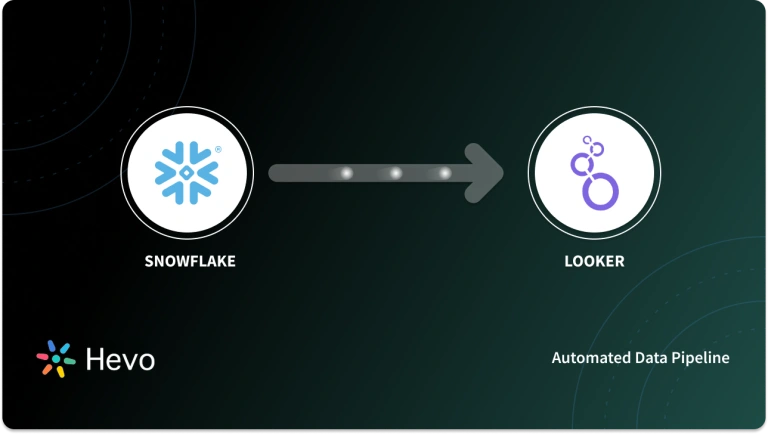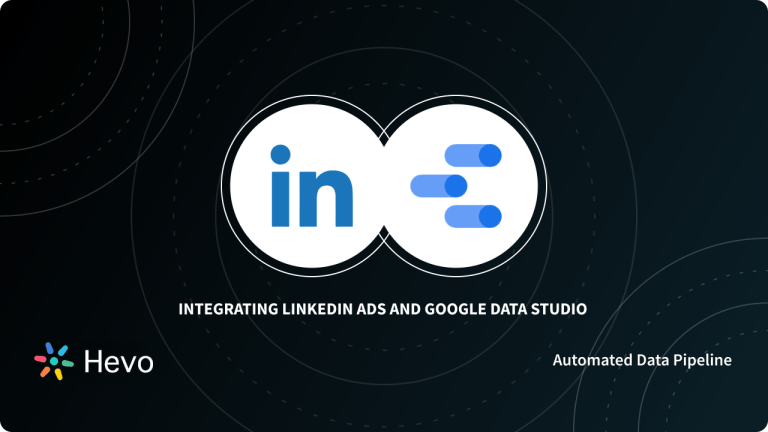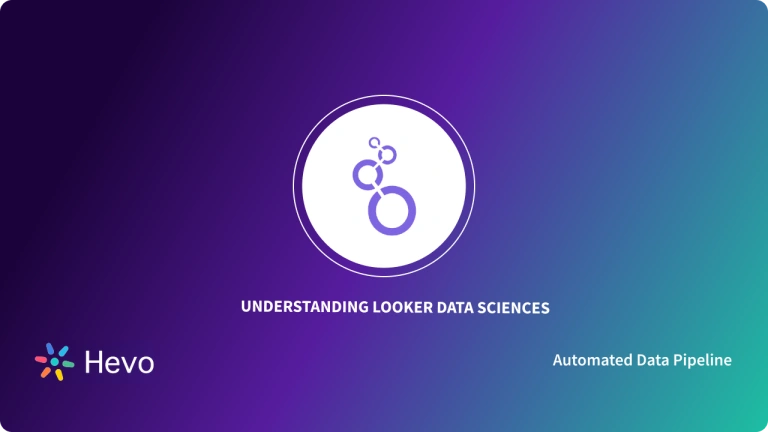Data-driven decision-making is now considered to be the backbone of business operations. Companies currently spend an immense amount of resources to understand their customers, business processes, and employees better. Hence, Business Intelligence tools have become necessary for organizations of all sizes operating across various domains.
The need for a Business Intelligence tool is apparent in any organization that wishes to derive valuable insights from its data. The insights provided by these tools help businesses get an understanding of their current market position and future goals. By leveraging the analysis of this data, businesses can interpret metrics in a much better way and use these findings to make informed strategic decisions.
There are a wide variety of Business Intelligence tools available in the market that can be leveraged by businesses to perform the necessary analyses. One of the most popular Business Intelligence platforms is Looker. This article will provide you with an understanding of how you can set up Looker HubSpot Integration to perform an in-depth analysis of customer data.
Table of Contents
Introduction to Looker
Looker is a Web-based Data Visualization and Business Intelligence platform capable of converting Graphical User Interface (GUI) based user input into SQL queries and sending it directly to the database in live mode. It houses numerous built-in visualizations that give users the ability to analyze their data in real-time. Since Looker is always working in live mode with the database, it works in harmony with Cloud-based Data Warehouses like Google BigQuery, Amazon Redshift, or Snowflake, which scale up or down as per requirements to manage the levels of user concurrency and query load.
Looker houses a Data Modeling layer which is separate from the components that help visualize data. The functionalities offered by this layer can be leveraged by developers to transform data, perform numerous join operations across tables, etc., which can then be used by the business teams to perform the necessary analysis. This functionality is considered to be extremely important as it allows multiple developers to work parallelly on a model and merge their work with Github Sync.
More information on Looker can be found here.
Looking for the best ETL tools to connect your data sources? Rest assured, Hevo’s no-code platform helps streamline your ETL process. Try Hevo and equip your team to:
- Integrate data from 150+ sources(60+ free sources).
- Utilize drag-and-drop and custom Python script features to transform your data.
- Risk management and security framework for cloud-based systems with SOC2 Compliance.
Try Hevo and discover why 2000+ customers have chosen Hevo over tools like AWS DMS to upgrade to a modern data stack.
Get Started with Hevo for FreeUnderstanding the Key Features of Looker
The key features of Looker are as follows:
- Modern Business Intelligence: Since Looker provides access to reliable and up-to-date data, it can be used to create real-time dashboards for an in-depth and consistent analysis resulting in more precise reporting.
- Custom Applications: Looker gives users the ability to create custom applications that can deliver unique data experiences suited to each business. Looker also houses numerous embedded analytics solutions that provide users with the data they need to perform all necessary tasks.
- Advanced Integrations: Looker supports seamless integration with Google BigQuery, Snowflake, AWS Redshift along with 50+ SQL dialects. This gives users the ability to link with multiple databases, avoid database lock-in, and maintain multi-cloud data environments.
- Advanced Hosting: Looker supports hosting on public Cloud-based platforms such as Google Cloud Platform (GCP) or Amazon Web Services (AWS) along with other multi-cloud and hybrid environments.
Introduction to HubSpot
HubSpot is a well-known Cloud-based CRM and an Inbound Marketing & Sales platform. It helps companies attract visitors, acquire leads, and convert them into customers. HubSpot is capable of doing this by providing its users with a variety of functionalities that allow Marketing & Sales teams at any organization to manage their key activities such as Content Creation, Social Media Sharing, Lead Capture, Workflow Management, Sales Pipeline Mapping, Performance Tracking, etc. all through a Single Platform.
Hence, it allows businesses to be better equipped in managing Marketing & Sales activities efficiently and make a methodical plan on how they can effortlessly nurture leads through a buyer’s journey. In simple terms, it can be said that HubSpot is a software platform designed to help businesses market and sell more effectively.
More information on HubSpot can be found here.
Understanding the Key Features of HubSpot
The key features of HubSpot are as follows:
- HubSpot Marketing Hub: Provides all functionalities required to efficiently run Marketing Campaigns that can attract and engage all potential & current customers. It houses various tools that allow businesses to manage their Social Media, Blogs, SEO, Emails, Landing Pages, etc. HubSpot Marketing Hub can also be used to create riveting content that can be used to engage all current and potential leads and customers.
- HubSpot Sales Hub: Provides all required tools that can help the Sales team of an organization convert leads into paying customers. It houses all functionalities that can be used by the Sales team to easily contact leads and existing customers. These functionalities include Meeting Scheduler, Calling, Pipeline Tracking, etc.
- HubSpot CRM: HubSpot Customer Relationship Management (CRM), as the name suggests is used to manage and improve the relationship between the business and leads or customers. It houses various tools that can help businesses track and categorize customers based on various parameters. These tools provide businesses the ability to store and manage Contact Information, record and update Conversion Status for Leads, etc.
- HubSpot Service Hub: Provides all functionalities that help ensure quality support to existing customers. HubSpot Service Hub provides various powerful tools such as Support Ticket Management, Reporting, Live Chats, etc. to ensure that the product users face minimal issues that are resolved at the earliest.
Understanding the Need for Looker HubSpot Integration
As businesses grow, the amount of Marketing, Sales, CRM data, etc. they handle also increases. Most businesses make use of existing platforms like HubSpot to manage this data instead of maintaining a record of it manually. Businesses rely on such tools primarily due to their ease of use and ability to automate various tasks that have to be performed regularly.
Although tools like HubSpot can be used to perform a simple analysis by leveraging Level-One Performance Metrics, it is not possible to perform an in-depth analysis or create custom reports. Hence, businesses feel the need to set up Looker HubSpot Integration to perform a comprehensive analysis of their data and derive meaningful insights.
Manual Looker HubSpot Integration
Users can manually set up Looker HubSpot Integration by first extracting the required data from HubSpot as a CSV file and then importing it in Looker. This can be done by implementing the following steps:
- Step 1: Log in to your HubSpot account and navigate to Account > Reports.
- Step 2: Click on Traffic Analytics, Events, or Campaign Analytics based on requirements.
- Step 3: Use the filters at the top to specify a date range and frequency.
- Step 4: Click Export in the upper right corner.
- Step 5: Click the File Format dropdown and select CSV.
- Step 6: Click Export. You will now receive a link to download the CSV file in your mailbox.
- Step 7: Download the file and save it on your local system.
- Step 8: Open a third-party CSV to SQL tool of your choice. For example, https://csv-sql.web.app/ can be used for this example.
- Step 9: Drag and drop the downloaded CSV file into the text section on the homepage.
- Step 10: Click Generate LookML. This will generate a LookML query for your CSV data.
- Step 11: The LookML query generated has to be then run on Looker using the Add to Project functionality and then selecting Run.
This process shows how Traffic, Campaign, or Events data can be exported from HubSpot to manually set up Looker HubSpot Integration. For information on how all the data on Prospects, Workflows, Blogs, etc. can be exported from HubSpot, refer to this. The same process can be followed for importing the data into Looker.
Limitations of Manual Looker HubSpot Integration
The limitations of setting up Looker HubSpot Integration manually are as follows:
- The new table that is created in Looker is static. This means that any changes to the underlying CSV or new data in HubSpot will not be automatically reflected in the LookML view file. Hence, the process to integrate data has to be repeated every time the data is to be analyzed.
- Manual Looker HubSpot Integration can only be considered as a good idea for smaller datasets. It is not scalable for a CSV with a large number of rows, and cannot handle any changes in the data structure.
- All columns that are imported into Looker will be of data type String. Hence, any dates or numbers will have to be converted into their true data types manually.
- The LookML query does not assign any attribute as Primary Key and hence, that assignment has to be done manually.
Conclusion
This article provided you with a step-by-step guide on how you can set up Looker HubSpot Integration manually or using Hevo. There are certain limitations associated with the manual method. If those limitations are not a concern to your analysis, then the manual method is the best option but if it is, then you should consider using automated Data Integration platforms like Hevo.
Visit our Website to Explore HevoHevo helps you directly transfer data from a source of your choice to a Data Warehouse, Business Intelligence tools such as Looker, or desired destination in a fully automated and secure manner without having to write the code. It will make your life easier and make data migration hassle-free. It is User-Friendly, Reliable, and Secure. It helps transfer data from HubSpot to a destination of your choice for free.
FAQ on Looker Hubspot Integration
Does HubSpot integrate with Looker Studio?
Yes, HubSpot integrates with Looker Studio using third-party connectors like Hevo allowing you to visualize HubSpot data in Looker Studio (formerly Google Data Studio).
What is Looker used for?
Looker is used for data analytics and business intelligence. It enables users to explore, visualize, and share real-time data insights from multiple data sources using SQL-based modeling.
Is Google Analytics same as Looker?
Google Analytics and Looker are not the same. Google Analytics is a tool specifically for tracking website traffic and user behavior, while Looker is a general-purpose BI tool for creating custom data models, visualizations, and reports across various data sources.
Details on Hevo’s pricing can be found here. Want to take Hevo for a spin? Sign Up for a 14-day free trial and experience the feature-rich Hevo suite first hand.
Tell us about your experience of going through Looker Hubspot Integration. Let us know in the comments section below!





